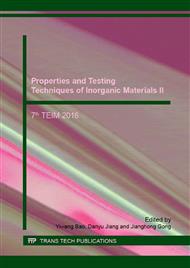p.240
p.245
p.250
p.255
p.261
p.266
p.271
p.276
p.282
Investigation on Synthesis and Property of Tb3+/Dy3+ Co-Doped Gd3Al5O12 Phosphor
Abstract:
The (Gd0.9-xTb0.1Dyx)3Al5O12 (x=0-0.04, GdAG:Tb3+/Dy3+) solid solution was acquired by calcining their respective precursor prepared via co-precipitation method at 1500 °C. The performance of GdAG:Tb3+/Dy3+ powders was characterized by combined technology of Fourier transform infrared absorption spectra (FT-IR), X-ray diffraction (XRD), field emission scanning electron microscope (FE-SEM) and photoluminescence (PL) spectrum analyses. The metastable Gd3Al5O12 could be stabilized by doping smaller Tb3+ ions of 10 at.%. Under the optimal UV excitation of 275 nm, the GdAG:Tb3+/Dy3+ phosphors exhibit vivid green emission at 548 nm which were attributed to the 5D4→7F5 transition of Tb3+. The CIE chromaticity coordinate was determined at (~0.32, ~0.48) with the color temperature of ~5872 K. Compared to the Dy3+-free (Gd0.9Tb0.1)AG phosphor, the emission intensity of Dy3+-doped phosphors display stronger owing to the efficient energy transfer from Dy3+ to Tb3+. The optimal amount of Dy3+ in GdAG:Tb3+/Dy3+ phosphors was determined to be ~2.5 at.% (x=0.025). The GdAG:Tb3+/Dy3+ phosphors developed in present work are expected to be a new type of green phosphor widely used in the lighting and display areas.
Info:
Periodical:
Pages:
261-265
Citation:
Online since:
January 2017
Authors:
Price:
Сopyright:
© 2017 Trans Tech Publications Ltd. All Rights Reserved
Share:
Citation:


